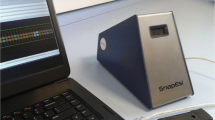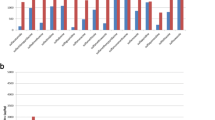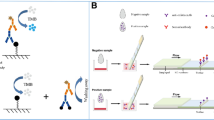Abstract
A new system for the analysis of antimicrobial residues in raw milk was optimized by combining a microbial inhibitor tube test (Eclipse Farm) and a device (e-Reader) that integrates incubation at 65 °C and colour change continuous monitoring. The system determines automatically the end point of the assay and interprets the results in an objective way. Thus, the new method is adapted for the use at farms and small dairies since it simplifies the analysis and increases the accuracy of the results. The performance of a new system was validated according to the European Commission Decision 2002/657/EC. Limits of detection of the new system were firstly evaluated for 30 molecules from several families of antimicrobials and were found to be close to the European maximum residue limits (MRLs). Detection capabilities were also determined for six molecules representing the main antimicrobial groups used in dairy husbandry (penicillins, cephalosporins, tetracyclines, sulphonamides, macrolides and aminoglycosides). All molecules were detected at or below the MRL level. Ruggedness was also studied, demonstrating that the new method was unaffected by reasonable changes in the procedure (sample volume, incubation temperature, test batch). Applicability was demonstrated in raw cow milk regardless fat and protein content or high somatic cell counts. Eclipse Farm coupled to e-Reader has proved to be a valuable tool for the screening of a broad-spectrum of antimicrobial residues in raw milk.



Similar content being viewed by others
References
Anonymous. Guidelines for the validation of screening methods for residues of veterinary medicines (initial validation and transfer of method). Community Reference Laboratories Residues, Document of 21 January 2010, pp. 1–18. http://crl.fougeres.anses.fr/publicdoc/Guideline_Validation_Screening_en.pdf. Accessed 23 September 2014
Cerny A (1996) Side effects and consequences of frequently used antibiotics in clinical practice. Schweiz Med Wochenschr 126:528–534
Commission Decision 2002/657/EC of 12 August 2002 implementing Council Directive 96/23/EC concerning the performance of analytical methods and interpretation of results. Off J Eur Comm L 221:8–36
Commission Regulation (EU) No 37/2010 of 22 December 2009 on pharmacologically active substances and their classification regarding maximum residue limits in foodstuffs of animal origin. Off J Eur Union 2010 L15:1–72
Council Directive (EEC) No. 96/23/EC of 29 April 1996 on measures to monitor certain substances and residues thereof in live animals and animal products. Off J Eur Comm L. 125:10–32
Demoly P, Romano A (2005) Update on beta-lactam allergy diagnosis. Curr Allergy Asthma Rep 1:9–14
EMEA (1997) Committee for veterinary medical products. Tylosin. Summmary report (3). London. http://www.ema.europa.eu/docs/en_GB/document_library/Maximum_Residue_Limits_-_Report/2009/11/WC500015764.pdf. Accessed 10 March 2015
EMEA (2001) Committee for veterinary medical products. Gentamicin. Summmary report (3). London. http://www.ema.europa.eu/docs/en_GB/document_library/Maximum_Residue_Limits_-_Report/2009/11/WC500014350.pdf. Accessed 10 March 2015
Gaudin V, Hedou C, Rault A, Verdon E (2010) Validation of a Five Plate Test, the STAR protocol, for the screening of antibiotic residues in muscle from different animal species according to European Decision 2002/657/EC. Food Addit Contam 27:935–952
Gaudin V (2013) Rapport de synthèse des études préliminaire et collaborative pour le Delvotest T (DSM, Pays-Bas) dans le cadre de la marque NF Validation®Rapport de synthèse du Delvotest. http://nf-validation.afnor.org/wp-content/uploads/2014/03/Synt-DSM-28-02-02-12_fr.pdf. Accessed 10 March 2015
Hassani M, Lazaro R, Perez C, Condon S, Pagan R (2008) Thermostability of oxytetracycline, tetracycline, and doxycycline at ultrahigh temperatures. J Agric Food Chem 56:2676–2680
International Dairy Federation (2010) Current situation and compilation of commercially available screening methods for the detection of inhibitors/antibiotic residues in milk. IDF Bulletin No. 442. Int Dairy Fed, Brussels, Belgium
ISO 13969:2003/IDF 183 Milk and milk products—guidelines for a standardized description of microbial inhibitor tests, pp 1–11
Le Breton MH, Savoy-Perroud MC, Diserens JM (2007) Validation and comparison of the Copan Milk Test and Delvotest SP-NT for the detection of antimicrobials in milk. Anal Chim Acta 586:280–283
Luitz M, Suhren G (1995) Advantages of photometric evaluation of microbial inhibitor test. In: Residues of antimicrobials drugs and other inhibitors in milk, IDF Special Issue No. 9505, International Dairy Federation, Brussels, pp 177–181
Mata L, Sanz D, Razquin P (2014) Validation of the Explorer 2.0 test coupled to e-Reader for the screening of antimicrobials in muscle from different animal species. Food Addit Contam 31:1496–1505
Pikkemaat MG (2009) Microbial screening methods for detection of antibiotic residues in slaughter animals. Anal Bioanal Chem 395:893–905
Regulation (EC) No. 726/2004 of 31 March 2004. Laying down community procedures for the authorisation and supervision of medicinal products for human and veterinary use and establishing a European Medicines Agency. Off J Eur Comm L 136:1–33
Reybroeck W, Ooghe S (2012) Validation report of Delvotest T, http://www.favv.be/laboratoires/methodes/lnr/_documents/2012-01-06_ValidationDelvotestT_en.pdf. Accessed 10 March 2015
Roca M, Villegas L, Kortabitarte ML, Althaus RL, Molina MP (2011) Effect of heat treatments on stability of β-lactams in milk. J Dairy Sci 94:1155–1164
Sanz D, Mata L, Condon S, Sanz MA, Razquin P (2012) Performance of a new microbial test for quinolone residues in muscle. Food Anal Methods 4:212–220
Stead SL, Ashwin H, Richmond SF, Sharman M, Langeveld PC, Barendse JP, Stark J, Keely BJ (2008) Evaluation and validation according to international standards of the Delvotests SP-NT screening assay for antimicrobial drugs in milk. Int Dairy J 18:3–11
WHO (2014) Antimicrobial resistance: global report on surveillance. Geneva. http://apps.who.int/iris/bitstream/10665/112642/1/9789241564748_eng.pdf?ua=1. Accessed 23 September 2014
Acknowledgments
We thank to AILA and Javier Gallart for providing the milk samples for this study. The authors would like to thank Inma Domingo and Cristina Lizama for the technical assistance and Elena Dominguez for the review of the manuscript.
Conflict of Interest
The authors are employees of ZEULAB, the manufacturer of the Eclipse farm test. This article does not contain any studies with human or animal subjects.
Author information
Authors and Affiliations
Corresponding author
Rights and permissions
About this article
Cite this article
Mata, L., Sanz, D. & Razquin, P. Performance of Eclipse Farm Test Coupled to e-Reader for Antibiotic Residues Detection in Raw Milk. Food Anal. Methods 9, 519–527 (2016). https://doi.org/10.1007/s12161-015-0210-y
Received:
Accepted:
Published:
Issue Date:
DOI: https://doi.org/10.1007/s12161-015-0210-y




